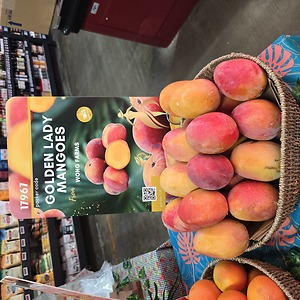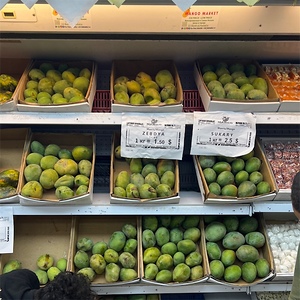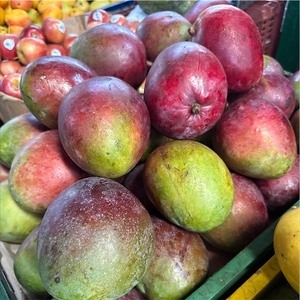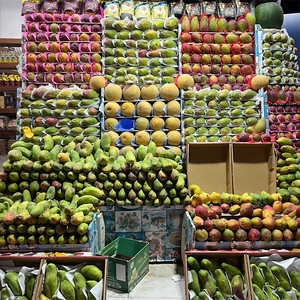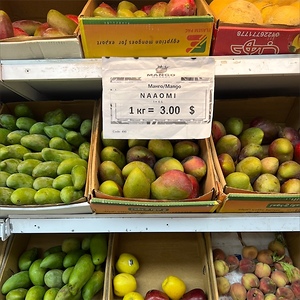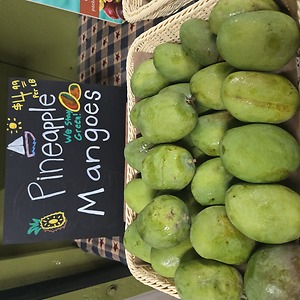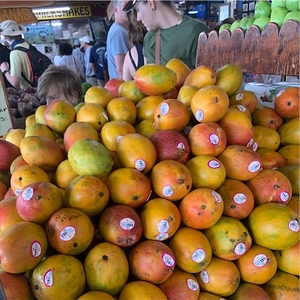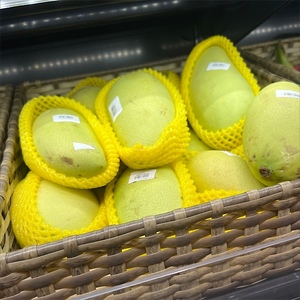

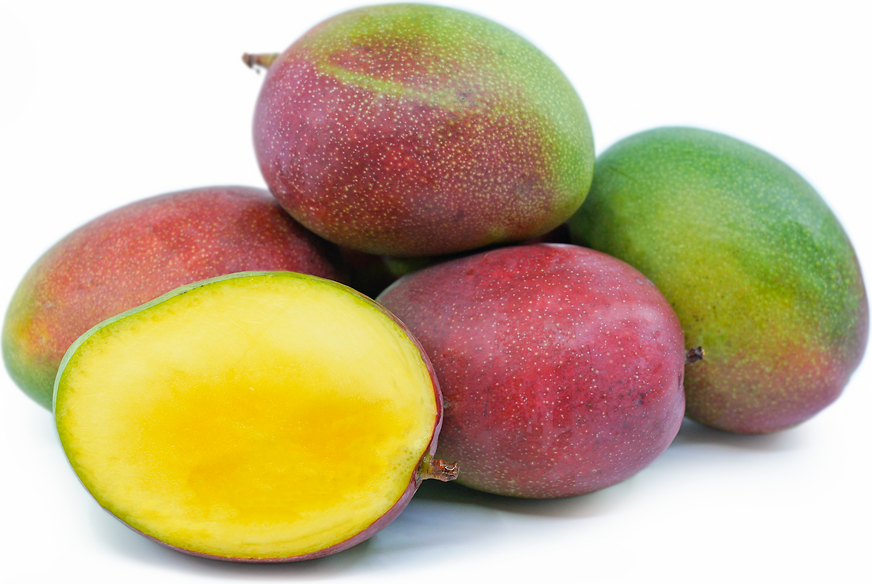
Mangoes
Estimated Inventory, 8 ct : 82.25
This item was last sold on : 07/27/25
Description/Taste
Mangoes range greatly in size, measuring anywhere from 5 to 30 centimeters in length, and weighing from 4 ounces up to 5 pounds. They have leathery, smooth skin, and they can vary in shape from long and slender, to kidney-shaped, or even somewhat round. Their skin is multi-colored with different blends of red, yellow and green, depending on the variety. The succulent, vibrant yellow to orange flesh is aromatic and juicy, with a texture similar to a peach. The flavor is complex and sweet, with notes of peach, coconut, and vanilla or caramel, and is sometimes balanced with a slight tartness. The skin of Mangoes is inedible, and actually contains a sap that can be irritating to some people.
Seasons/Availability
Mangoes are available year-round.
Current Facts
Mangoes are botanically classified as Mangifera Indica, which translates as “an Indian plant bearing Mangoes,” and they are known by many nicknames across the globe, such as King of Fruit, Apple of the Tropics, and even Fruit of the Gods. There are two races or strains of Mangoes, one from India and the other from the Philippines and Southeast Asia. They are a member of the cashew family alongside poison sumac and poison ivy, and contain the same itchy chemical, urushiol, in their skin. However, it’s less concentrated, and people will have different levels of reaction, or no reaction at all to contact. Mangoes are further categorized as a drupe, also known as a stone fruit. There are hundreds of varieties of Mangoes around the world, with about 1,000 in India alone, though only a few are marketed in the United States.
Nutritional Value
Mangoes are a good source of fiber, Vitamin A, Vitamin C, and potassium. They also contain natural enzymes that assist in breaking down proteins.
Applications
Mangoes can be used in both raw and cooked applications. Just like an avocado, a ripe Mango will give slightly to pressure. Note that the skin doesn't always indicate ripeness due to the variations in color among varieties. Mangoes are a popular ingredient for fresh salsas and chutneys, and are widely used in desserts and baked goods. Use Mangoes to flavor ice cream and gelato, blend or juice for smoothies and other drinks, or slice and dry for a naturally sweet snack. Mangoes contain natural enzymes that help break down proteins, and hence are commonly used in marinades to tenderize meats, like pork. In India, Mango is pureed and mixed with milk or cream and used as a dipping sauce for a type of baked pastry similar to a donut hole. In Thailand, it is used for Mango sticky rice, a traditional dessert made with rice, fresh Mango and coconut milk. The sweet-tart flavor of Mangoes compliments rich, creamy cheeses, and also balances the heat of smoky dishes, pairing well with jalapeno or chile. Mangoes can also be paired with other tropical fruits, apples, berries, citrus, melon and coconut, as well as flavors like vanilla, cinnamon, and caramel. Mangoes that are still firm will continue to ripen if stored at room temperature. Once fully ripe, they can be stored in the refrigerator for about 5 days.
Ethnic/Cultural Info
Mangoes are prominent in both folklore and theology, and have been an integral part of India's culture for at least 4,000 years as a symbol of love, pleasure and prosperity. In Hinduism, the god of love, Kama, decorates his bow and arrow with five flowers, the most potent arrow tipped with a Mango blossom. In ancient holy books from India, the Mango tree is called Kalpavriksha, which is Sanskrit for "wish-granting tree," and Buddha was said to have meditated in its shade. Even the paisley pattern, which was developed in India, is based on the shape of the Mango.
Geography/History
Mangoes are native to Southern Asia, especially Burma and eastern India, where they have been cultivated for thousands of years. The earliest mention of Mango is in the Hindu scripture dating back to 4000 BCE, though fossil evidence indicates that the Mango could be much older than that. Historians believe that Mangoes spread across the globe in the hands of traders and travelers, like Buddhist monks who exchanged the fruit as a gift, and Persian vendors who brought the fruit westward with the spice trade. The Portuguese, who landed in Calcutta in 1498, were the first to establish a Mango trade and introduce grafting on Mango trees. During the 16th and 17th centuries, sea-faring Portuguese explorers brought the Mango to Western Africa and eventually to Brazil, and from there the fruit made its way to the West Indies. It reached Mexico in the hands of Spanish explorers in the early 19th century, and finally made its way to the US in the mid 19th century, specifically Florida and California, where the fruit is still commercially cultivated. Today, Mangoes grow in tropical and subtropical climates all over the world, notably Brazil, Mexico, Ecuador, Guatemala, and Peru.
Featured Restaurants
Restaurants currently purchasing this product as an ingredient for their menu.
| Mothership | San Diego CA | 858-342-3609 |
| Shore Rider | La Jolla CA | 858-412-5308 |
| Junkyard Sports Bar and Grill | Oceanside CA | 760-407-8500 |
| Brigantine Corp | San Diego CA | 858 926 9644 |
| Crown Point Catering | San Diego CA | 619-223-1211 |
| Cove House | La Jolla CA | 858-999-0034 |
| Panama 66 | San Diego CA | 619-206-6352 |
| Tom Hams Light House | San Diego CA | 619-291-9110 |
| Juniper & Ivy | San Diego CA | 858-481-3666 |
| Portside Pier (Ketch Tasting Deck) | San Diego CA | 858-268-1030 |
| The Santaluz Club Inc - Bistro Kitchen | San Diego CA | 858-759-3150 |
| The Lion Share Bar | San Diego CA | 619-564-6924 |
| Institutes of Health LLC | San Diego CA | 800-270-5016 |
| Beach Terrance Inn | Carlsbad CA | 760-729-5951 |
| Hazel & Jade Bakery | San Diego CA | 804-815-8052 |
| Pizzeria Luigi | San Diego CA | 610-539-7025 |
| Miguel's Old Town | San Diego CA | 619-298-9840 |
| La Jolla Beach & Tennis Club | San Diego CA | 619-816-8319 |
| Brigantine Pt Loma | San Diego CA | 619-224-2871 |
| Villa Capri Poway | Poway CA | 858-391-9400 |
| Harney Poway Sushi | Poway CA | 760-533-0051 |
| El Sueno | San Diego CA | 619-972-6286 |
| Culinary Kitchen Catering and Events | Coronado CA | 619-798-8477 |
| The Wild Thyme Company | San Diego CA | 858-527-0226 |
| Crest Cafe | San Diego CA | 619-295-2510 |
| The Santaluz Club Inc - Banquet | San Diego CA | 858-759-3150 |
| The Remy | San Diego CA | 619-886-1358 |
| Royal Polaris Sportfishing | San Diego CA | 619-226-8030 |
| Parkhouse Eatery | San Diego CA | 619 295 7275 |
| Nomade Tapas and Records | San Diego CA | 619-616-1670 |
| Jalisco Cantina | Carlsbad CA | 619-204-5945 |
| Jo's Mission Hills Diner | San Diego CA | 619-417-3801 |
| Fort Oak | San Diego CA | 619-795-6901 |
| Revolution Roasters (Carlsbad) | Carlsbad CA | 760-330-6827 |
| Lumi | San Diego CA | 619-955-5750 |
| C 2 C | San Diego CA | 619-972-9345 |
| Hawaiian Fresh Seafood | San Diego CA | 858-299-8862 |
| Pacific Yacht Agents | Los Angeles CA | 808-214-0970 |
| Kairoa Brewing Company | San Diego CA | 858-735-0051 |
| Ju-Ichi | San Diego CA | 619-800-2203 |
| Artifact at Mingei | San Diego CA | 619-846-2164 |
| Southwestern Yacht Club | San Diego CA | 619-222-0438 |
| Fortunate Son | San Diego CA | 619-806-6121 |
| South O Brewing Catering | Oceanside CA | 925-381-5392 |
| The Remy (bar) | San Diego CA | 619-886-1358 |
| Hotel La Jolla - Sea & Sky | La Jolla CA | 858-459-0261 |
| Monarch School | San Diego CA | 619-804-1766 |
| The Guild Hotel | San Diego CA | 619-764-5108 |
| Firefly Beach | San Diego CA | 619-222-6440 |
| Manna | Encinitas CA | 510-366-3057 |
| Blue Ocean La Jolla | La Jolla CA | 858-999-0323 |
| Revolution Roasters | Oceanside CA | 760-330-6827 |
| Sheraton La Jolla | San Diego CA | 858-453-5500 |
| Coast Catering | Escondido CA | 619-295-3173 |
| Pacific Regent La Jolla | San Diego CA | 858-597-8008 |
| Cutwater Spirits | San Diego CA | 619-672-3848 |
| Hamburger Hut | Encinitas CA | 760-230-1999 |
| Fifty Two Remedies Bar | San Diego CA | 858-707-7016 |
| Marriott Gaslamp | San Diego CA | 619-696-0234 x6051 |
| Miguel's Cocina Pt Loma | San Diego CA | 619-224-2401 |
| Fifty Two Remedies | San Diego San Diego | 858-707-7016 |
| Giaola | Carlsbad CA | 858-266-9303 |
| Mille Fleurs | Rancho Santa Fe CA | 858-756-3085 |
| Casa | San Diego CA | 619-581-3003 |
| GoodOnYa | Encinitas CA | 949-295-3145 |
| Aztec Shop Catering | San Diego CA | 619 594-3576 |
| El Sueno (TAKO) | San Diego CA | 619-972-6286 |
| The Farm Golf Club | Rancho Santa Fe CA | 858-756-5585 |
| Something Homemade | Vista CA | 858-245-1004 |
| Brigantine Coronado | Coronado CA | 619-435-4166 |
| Sushi Nekosan | La Jolla CA | 858-999-0999 |
| Marys Gourmet Salads | La Jolla CA | 858-925-4690 |
| Miguel's Cocina Coronado | Coronado CA | 619-437-4237 |
| Kona Kai Resort and Marina | San Diego CA | 619-221-8000 |
| Deeply Nourished | La Jolla CA | 808-489-7366 |
| Oscars Brewing Company | Temecula CA | 619-695-2422 |
| Ron Oliver | San Diego | 619-295-3172 |
| Third Corner Encinitas | Encinitas CA | 760-942-2104 |
| Le Coq | La Jolla CA | 858-427-1500 |
| The Country Club Of Rancho Bernardo | San Diego CA | 858-487-1134 |
| Palmys | San Diego CA | 858-886-7111 |
| Asti Ristorante | San Diego CA | 619-232-8844 |
| JRDN Restaurant | San Diego CA | 858-270-5736 |
| The Bower | Coronado CA | 949-212-3192 |
| Pamplemousse Grill | Solana Beach CA | 858-792-9090 |
| Herb & Sea (Bar) | Encinitas CA | 858-587-6601 |
| The Sushi Stand | San Diego CA | 619-394-2395 |
| Louisiana Purchase | San Diego CA | 619-255-8278 |
| Casero Taqueria | Carlsbad CA | 760-533-4997 |
| PFC Fitness Camp | Carlsbad CA | 888-488-8936 |
| Viejas Casino Grove Steakhouse | Alpine CA | 800-295-3172 |
| The Kitchen at MCASD | La Jolla CA | 619-880-8719 |
| La Costa Resort & Spa Pastry | Carlsbad CA | 760-431-8455 |
| Hilton Garden Inn - Homewood Suites San Diego | San Diego CA | 619-696-6300 |
| Pacifica Del Mar | Del Mar CA | 858-792-0505 |
| Kitchens for Good (SD) | San Diego CA | 619-450-4040 |
| Ketch Grill and Taps | San Diego CA | 858-268-1030 |
| Living Coast Discovery Center | Chula Vista CA | 619-409-5900 |
| Miguel's 4S Ranch Bar | San Diego CA | 858-924-9200 |
| Portside Pier (Miguels) | San Diego CA | 858-268-1030 |
| US Grant Hotel Grill | San Diego CA | 619-232-3121 |
| Portside Pier (Brigantine) | San Diego CA | 858-268-1030 |
| Brigantine Escondido | Escondido CA | 760-743-4718 |
| Blue Ocean | Carlsbad CA | 760-434-4959 |
| Sycuan Casino | El Cajon CA | 619-445-6002 |
| Margaritaville Hotel SD (Kitchen) | San Diego CA | 619-819-9500 |
| Parisien Gourmandises | La Jolla CA | 858-352-6552 |
| Rose Café | Carlsbad CA | 310-399-0711 |
| Miguel's Cocina Carlsbad | Carlsbad CA | 760-759-1843 |
| Botanica | San Diego CA | 619-310-6320 |
| Corbeaux Wine & Tea House | Temecula CA | 909-567-6109 |
| Shogun Sportfishing | San Diego CA | 619-226-8030 |
| US Grant Hotel Main | San Diego CA | 619-232-3121 |
| Bernini's Bistro | La Jolla CA | 858-454-5013 |
| Garbatella Osteria Bar | Chula Vista CA | 619-651-1185 |
| Viejas Casino Banquets | Alpine Ca | 619-295-3172 |
| Saiko Sushi-Coronado | Coronado CA | 619-435-0868 |
| Coco Maya by Miss Bs | San Diego CA | 858-245-3780 |
| Shoreside Support Boat | San Diego CA | 704-277-7929 |
| Marriott Del Mar | San Diego CA | 858-369-6029 |
| Culinary Concepts | San Diego CA | 619-865-1918 |
| San Diego Yacht Club | San Diego CA | 619-758-6334 |
| Fay's Diner and Cafe | San Diego CA | 661-858-8895 |
| Sensations Salud | San Diego CA | 619-933-3489 |
| Lovesong | San Diego CA | 602-502-3460 |
| The Lion Share Bar 2025 | San Diego CA | 619-564-6924 |
| Frenchy's Hideout | San Diego CA | 858-345-7379 |
| Bridges at Rancho Santa Fe | Rancho Santa Fe CA | 858-759-6063 |
| Glenbrook Health Center | Carlsbad CA | 760-704-1000 |
| Temaki | Encinitas CA | 702-489-2129 |
| Rosewood Social | San Juan Capistrano CA | 669-243-8403 |
| Urban Kitchen Catering | San Diego CA | 619-276-8803 |
| The Seabird Resort | Oceanside CA | 442-222-9505 |
| Cal A Vie | Vista CA | 760-945-2055 |
| Estancia Adobe | San Diego CA | 858-550-1000 |
| UnaMas on Adams | San Diego CA | |
| Gossip Grill | San Diego CA | 619-260-8023 |
| Miguel's 4S Ranch | San Diego CA | 858-924-9200 |
| Seasoned Catering and Events | San Diego CA | 619-246-4909 |
| Roppongi (IB) | Imperial Beach CA | 858-456-8018 |
| Belmont Park Cannonball | San Diego CA | 858-228-9283 |
| Leila | San Diego CA | 619-550-5412 |
| Webbcreationfood LLC | San Diego CA | 619-829-9194 |
| Del Mar Country Club | Rancho Santa Fe CA | 858-759-5995 |
| Extraordinary Desserts Union St. | San Diego CA | 619-294-7001 |
| Red Tail Catering | San Marcos CA | 858-605-8219 |
| Reata Glen | Ladera Ranch CA | 949-545-2250 |
| Mitch's Seafood | San Diego CA | 619-316-7314 |
| Nectarine Grove | Encinitas CA | 760-944-4525 |
| Communion | San Diego CA | 619-606-5568 |
| Animae | San Diego CA | 619-925-7908 |
| Sago | Encinitas CA | 858-382-4047 |
| Chef Drew Mc Partlin | San Diego CA | 619-990-9201 |
| La Costa Resort & Spa Main Kitchen | Carlsbad CA | 760-930-7063 |
| Blue Whale | La Jolla CA | 808-868-8639 |
| Crust Pizzeria Carlsbad 2019 | Carlsbad CA | 760-944-1111 |
| La Jolla Country Club | San Diego CA | 858-454-9601 |
| Ridgeview Health Center | San Diego CA | 858-293-3950 |
| The Flavor Chef (Catering) | Vista CA | 619-295-3172 |
| Toast Catering | San Diego CA | 619-795-9135 |
| Brigantine Del Mar | Del Mar CA | 858-481-1166 |
| University Club | San Diego CA | 619-234-5200 |
| Coral Del Mar | Del Mar CA | 858-449-6679 |
| Birdseye Rooftop | San Diego CA | 619-206-7220 |
| Brigantine La Mesa | La Mesa CA | 619-465-1935 |
| Cody's La Jolla | La Jolla CA | 858-459-0040 |
| Harney Sushi | San Diego CA | 619-295-3272 |
| Rancho Santa Fe Golf Club | Rancho Santa Fe CA | 858-756-1582 |
| Brigantine Poway | Poway CA | 858-486-3066 |
| InterContinental Vistal Kitchen | San Diego CA | 619-501-9400 |
| A & M catering | San Diego CA | 206-802-8320 |
| Wormwood | San Diego CA | 619-573-0289 |
| Miho | San Diego CA | 619-365-5655 |
| Brigantine Imperial Beach | Imperial Beach CA | 619-591-1350 |
| LANA | Solana Beach CA | 602-758-2596 |
Recipe Ideas
Recipes that include Mangoes. One
Podcasts



